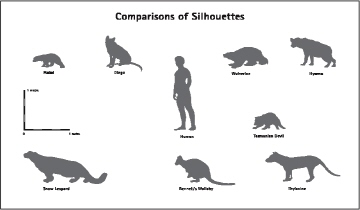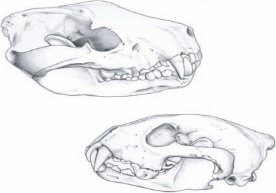Tasmanian Devil (7 page)
I opened the tent zip and stood scanning the area until the beam came to rest on a large full grown Tassie devil looking straight at me only ten metres away. Closer inspection revealed a shiny object (my bloody fork!) hanging out of its mouth. Since I needed that fork more than he did, I charged the devil who dropped the fork and bolted into the bush.
B
RENDAN
M
C
C
ROSSEN
, M
IENA
T
asmania's devil is twice lucky, having escaped the ancient fate of its mainland counterpart and the overt consequences of European settlement, which in a little over two hundred years has accounted for the extinction of almost half of the Australian continent's mammal species. Most infamously, the thylacine, the Tasmanian tiger, was hunted during the nineteenth century as a supposed threat to the island's sheep industry. It has not been seen for over 70 years and in 1986 was declared officially extinct. The devil has replaced the thylacine as the island's largest marsupial predator, but because devils are also reliant on scavenging, Tasmania no longer has a specialist cursorial (free-running) native terrestrial predator.
The Tasmanian tiger, a large pursuit predator, and the Tasmanian devil, a medium-sized ambush predator and scavenger, shared more than related names: their relationship in the wild was close and complex. Devils were preyed on by thylacines, but also benefited from the uneaten parts of the thylacines' prey. Being foragers, devils undoubtedly ate denned thylacine cubs, should they come across them unprotected. As thylacines became rarer, such incidental predation may even have hastened their demise. Old thylacines encroached on the devil's niche by scavenging. There may also have been competition for dens, given the preference of both species for caves, burrows and grass sags.
Anatomically the thylacine is dog-like (a good example of convergent evolution), is considerably more streamlined than the squat, stout devil, and properly described as a cursorial predator. Yet dentition studies carried out by Menna Jones confirm that devils and thylacines competed directly, their teeth demonstrating a significant niche overlap. Although the devil is only about half the weight of a thylacine, it is by comparison heavy-bodied and, with its speed over a short distance and powerful bite and forepaw grip, capable of bringing down prey larger than itself. She cites cases of devils attacking adult wombats of up to 30 kilograms.
1
Thylacines, however, show much less tooth breakage than devils, meaning less bone-eating. Thus, while the devil âhas a highly carnivorous dentition and trophic adaptions for bone consumption . . . The thylacine groups with the canids. Their molar teeth are intermediate in grinding and slicing functions and are quite slender, with no indications of adaption for bone consumption'.
2
The devil's comparatively greater tooth and associated jaw muscle strength leads Jones to conclude that âthe role of top predator in the Tasmanian ecosystem was, at the least, shared equally between thylacines and devils'.
3
Although the concept of âsharing and competing' may seem to be at odds with itself, there are successful examples elsewhere. Jaguars and pumas are roughly the same size as each other, but heavy-bodied jaguars take heavy prey such as peccaries, while the lighter-built pumas prey on smaller animals such as antelope. Jones speculates that the devil may have had a slight edge over the thylacine in taking heavy wombats.
Taxonomically, devils and thylacines are not that closely related, but their similarities and their greater differences provide insight into how evolutionary fine-tuning allowed them to coexist closely. They have in common distinctive markings: bold stripes, bold patches, which have camouflage, physiological and behavioural functions. Devil markings are important during feeding, the pure white flashes standing out at night in close interactions. The markings of both species are an indication of activity concentrated at dawn and dusk, less often during the day.

R.F. Ewer, a carnivore specialist in hyaenas and devils, speculated that a prototype/ideal canid would have both white markings and stripes to accentuate behavioural postures. While stripes aid in camouflage and possibly individual identification, white markings âmay serve to direct bites to relatively non-vulnerable areas'.
4
The thylacine has stripes, the devil has white patches. Where devil agonistic encounters result in bites they are typically on or near the rump where white markings are located (although the white chest-flash seems to play a role in initiating an encounter). Knowledge of devil marking is extremely limited. White flashes range from pronounced to marginal, with an estimated 16 per cent of animals being melanic, that is, all black.
The thick, largely non-prehensile tails of both species store fat. The devil's tail is important in physiology, locomotion and social behaviour. During high-speed motion it acts as a counterbalance.
The jaw gape of both species is wide, at 75â80 degrees, although for different reasons: thylacines used their gape to seize and suffocate or crush prey, while the gape and powerful teeth of the devil enable it to tear and gulp large lumps of food in a competitive manner, as well as to crush bones in order to consume them.
The animals' differences are pronounced. The devil's blackness is a sure asset for a small nocturnal creature; the thylacine's fawn or tan colouring shows a functional similarity to placental hunters such as wolves and wild dogs which hunt by day. An adult thylacine is about twice the weight and size of a devil. Anatomically it is considerably more streamlined than the squat, stout devil. This is because it is a cursorial predator, selecting its preyâgenerally a wallabyâand pursuing it relentlessly. Many early accounts refer to the thylacine's unhurried, dogged pursuit of prey, wearing its victim down through exhaustion, though it was undoubtedly capable of sharp speed over a short distance.
There was a long-held view that the thylacine was fussy and selective, consuming only the heart, kidneys and vascular tissue of its freshly killed prey, while the devil was a rapacious carrion eater. Clive Lord, director of the Tasmanian Museum in the 1920s, wrote:
One or more Tasmanian devils will often follow a thylacine on its hunting excursions. The thylacine will kill a wallaby or other small animal, select a few choice morsels, and pass on. The devils will carry on the feast and consume the remnants, bones and all.
5
Statements like this unwittingly consigned the two species to a strictly hierarchical relationship, and it is only in recent decades, through scientific studies, that the devil's predatory abilities have been recognisedâand the likelihood that tigers and devils coexisted in a robust relationship.
Is the devil unique or can it be likened to non-marsupial mammals? Convergent evolution results when unrelated species in unrelated environments evolve similar adaptations because they occupy similar niches. Understanding and appreciation of the Tasmanian devil will be enhanced by finding convergent ârelatives' elsewhere. There are three good examples: the northern hemisphere wolverine (
Gulo gulo
), the southern hemisphere ratel (
Mellivora capensis
) and the hyaenas (striped,
Hyaena
hyaena
; brown,
H. brunnea
; spotted,
Crocuta crocuta
).

Wolverines are sometimes referred to as the devil of the north. Their powerful teeth and
jaws are adapted for chewing frozen carrion and crunching bone. (Courtesy Daniel J. Cox, Natural Exposures Inc.)
Wolverines and ratels belong to the Mustelidae, the weasel family, which includes weasels, minks, polecats, otters, badgers and skunks.
Historically the wolverine has a broad circumpolar range, taking in Russia, the Scandinavian countries and North America. Despite the size of its range, in the words of the Wolverine Foundation, the umbrella organisation devoted to researching and protecting it, âEven today, the wolverine remains largely a mystery . . . one of the least understood and most fascinating creatures on earth'.
6

Comparative skull drawings of a Tasmanian devil (top) and a wolverine (bottom),
showing the similarities of a robust carnivore skull. (Ian Faulkner)
In the United States, wolverines were once found as far south as California but appear to be confined now to Idaho and Montana, although there have been recent sightings in the Rocky Mountains states. Their Canadian range is also shrinking. The wolverine occupies a predatorâscavenger niche one level down from the top predators, which in its range include wolves, bears, mountain lions and lynxes. This is not dissimilar to the Tasmanian devilâthylacine relationship.
Devils and wolverines have heavy builds, short powerful limbs, small round ears, weak eyesight, an excellent sense of smell and large heads to support their powerful jaws. (A wolverine skull in David Pemberton's office in the Tasmanian Museum and Art Gallery is often mistaken for a devil skull.) Both animals have white neck and throat patches, and are occasional tree climbersâonly juveniles in the case of devils, while generally wolverines are ânot considered to display arboreal behaviour'.
7
Devils and wolverines are habitually described as nocturnal animals, but both species can be active during daylight. They are both regularly described as bear-like, due particularly to the shape of the head, the small eyes and round ears, broad chest when upright, glossy coat and pronounced claws. One of the Wolverine Foundation's Frequently Asked Questions is whether the Tasmanian devil is a biological relative of the wolverine. (âNo . . . They may resemble each other physically, however they are distinctly different.')
8
Adult wolverines typically weigh 2â3 kilograms more than adult devils, much of which is fat for insulation, while their fur is long and thick and their pads broad for travelling in snow. Wolverines have low density distribution; devil densities vary from low to very high. Wolverines have an inbuilt fearlessness and will not hesitate to attack if threatened, whereas devils generally are timid. Wolverines use strong scents to mark their territory, which devils do not conspicuously do, being non-territorial (although devil latrines may serve a similar function). Wolverines, as solitary animals, are quiet, as are solitary devils, though both have a range of social vocalisations.
Like the devil, the wolverine's food habits âare weighted to scavenging'.
9
Wolverines are unfussy, opportunistic eaters and will cover large amounts of territory in search of food. They are known to attack incapacitated animals much larger than themselves but are generally recognised as voracious scavengers, so much so that early North American settlers nicknamed them Gluttons. Eggs, insects, birds, rodents, squirrels and hares all form part of their diet.
